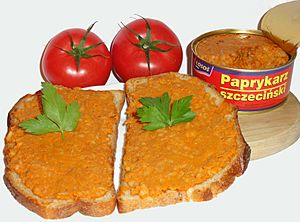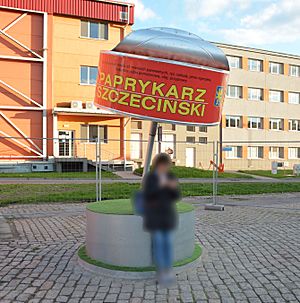Szczecin paprikash facts for kids

An open can of Szczecin paprikash with some of the paste spread on bread
|
|
| Alternative names | Polish paprikash |
|---|---|
| Type | Canned fish, spread |
| Region or state | Szczecin, Poland |
| Associated national cuisine | Polish cuisine |
| Invented | 1965–1967 |
| Main ingredients | Fish, rice, tomato paste, vegetable oil |
| Ingredients generally used | Onion, salt, paprika |
Szczecin paprikash (Polish: Paprykarz szczeciński), also known as Polish paprikash, is a popular Polish canned food. It's a tasty spread made from ground fish, rice, tomato paste, and vegetable oil. It gets its flavor from onion, salt, and other spices. It looks like a reddish-brown paste with small grains of rice mixed in.
This unique recipe was created in the 1960s by a Polish fishing company in the city of Szczecin. The idea came from a West African dish that Polish fishermen tried. Paprikash is a favorite snack, especially for students, and it's a symbol of Szczecin's local identity.
Contents
What's in a Name?
The name Paprykarz szczeciński is Polish. The word paprykarz means a spicy stew seasoned with paprika. It comes from the Hungarian word paprikás, which describes a dish like goulash made with meat, onions, paprika, and sour cream. The word szczeciński simply means "from Szczecin," which is a port city in northwestern Poland.
What is Szczecin Paprikash Made Of?
The exact ingredients for paprykarz szczeciński can be a bit different depending on who makes it. But usually, it includes ground fish, tomato paste, rice, onion, vegetable oil, and spices. A Polish rule from 1967 even mentioned "Nigerian pepper" as a main spice. This pepper might have been a special kind of chili or a mix of spices from Nigeria.
The spread is a smooth paste, ranging from light to dark red or reddish-brown. You can always see the grains of rice in it. It's usually firm, sometimes a bit dry, and can have a thin layer of oil on top. It's cooked to make it safe and then packed into metal cans.
The Story Behind Paprikash

The original recipe for paprykarz szczeciński was created by Wojciech Jakacki. He was a manager at a company called Gryf, which was a big fishing and fish processing company in Szczecin.
The idea for paprikash came from a smart plan to use up fish scraps. When workers cut blocks of frozen fish on Gryf's fishing boats, there were always small pieces left over. So, between 1965 and 1967, scientists at Gryf worked to create a new product from these scraps.
At that time, Gryf's fishing boats were often off the coast of West Africa. One of Gryf's co-founders, Bogusław Borysowicz, said the recipe was inspired by a West African dish called "chop-chop." Fishermen tried this dish in local ports. It had fish, rice, and a hot spice called "pima." In 1967, Jakacki and his team were recognized for their new idea, and the first cans of paprykarz szczeciński were made that same year.
At first, paprykarz szczeciński used scraps from different fish caught near West Africa, like red porgy. The tomato paste came from countries like Bulgaria, Hungary, and Romania, and the special spice came from Nigeria.
Over time, the type of fish used changed. This happened as Gryf's fishing boats moved to new areas around the world. For example, they used fish like Alaska pollock from the Pacific Ocean or southern blue whiting from near the Falkland Islands. The company had to move its fishing fleet several times because of wars or new fishing rules in different countries.
Paprikash Becomes Popular
Because it was cheap and lasted a long time, paprykarz szczeciński quickly became very popular in Poland. Students, artists, and hikers especially loved it. By the late 1970s and early 1980s, paprikash made up about half of all the canned fish Gryf produced each year.
This fish spread became a big export for Poland. It was sold to 32 different countries, including Japan, the United States, and the Soviet Union. There was even a report that Colombia copied the recipe and sold its own version to nearby countries!
In the 1980s, Poland faced economic problems, and the quality of paprikash went down. The Nigerian spice was replaced with cheaper Hungarian paprika, and there was less fish and more rice in the cans. Sometimes, you could even find small pieces of fins, scales, or bones in the paste.
Sales dropped in the mid-1980s because people heard that some of the fish used, southern blue whiting, had a tiny parasite. Consumers worried that this fish was still being used. Some people even thought the rice grains in the paste were parasite cysts! During those times when food was scarce, cans of paprikash and vinegar were often the only things left on store shelves.
The Future of Paprikash
In the early 1990s, Poland changed from a government-controlled economy to a market economy. This made it hard for big fishing companies like Gryf to keep going, and Gryf went out of business.
According to one of Gryf's co-founders, the original paprykarz szczeciński recipe was protected by a patent, but the documents were lost when the company closed. Because of this, the recipe and name are not legally protected anymore. This means many different companies in Poland can make their own versions of the spread and call it paprykarz szczeciński, even if they don't use the original recipe or are not located in Szczecin. Some even use freshwater fish instead of ocean fish.
In 2010, the Polish Ministry of Agriculture added paprykarz szczeciński to a list of traditional products. This was a step towards protecting the name and showing that it comes from Szczecin under European Union law.
Paprikash in Polish Culture
Paprykarz szczeciński was one of the most famous brands in Poland during the communist era. Even though it's not made in Szczecin anymore, its popularity and connection to the city have made it a part of Szczecin's identity. It shares this special status with another local food, a meat-filled pastry called pasztecik szczeciński.
Sometimes, people from other parts of Poland jokingly use the word "Paprykarz" to refer to people from Szczecin. They especially use it for the players and fans of Pogoń Szczecin, the city's local soccer team.



